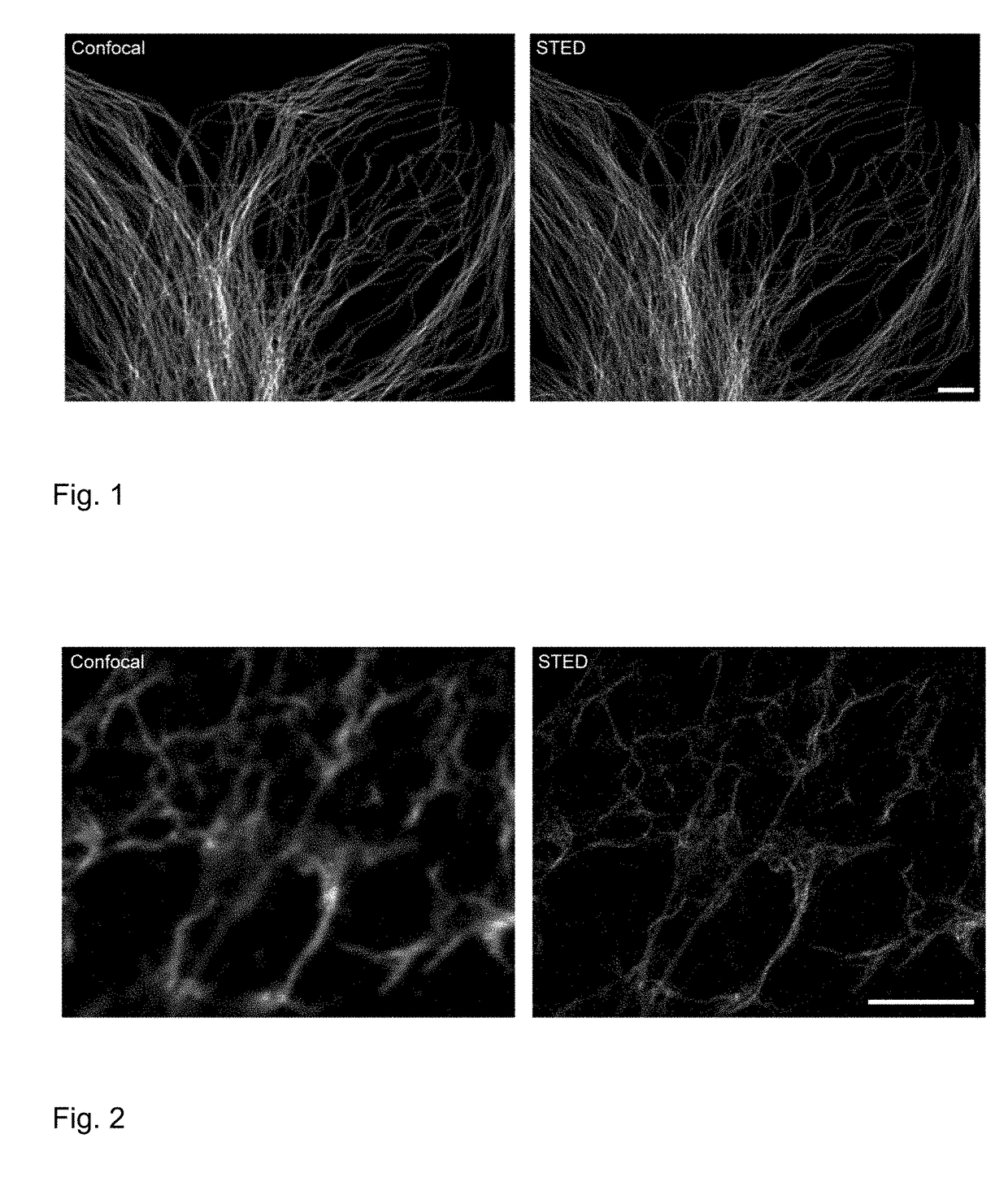Novel dyes with phosphinic acid, phosphinate, phosphonate and phosphonamidate substituents as auxochromic groups and methods for preparing the same
a technology of auxochromic group and dye, which is applied in the field of new dyes with auxochromic group of phosphinic acid, phosphinate, phosphonate and phosphonamidate substituents, can solve the problems of bioconjugation technique, many widely used, and bright lipophilic triarylmethanes are cationic dyes and bind
- Summary
- Abstract
- Description
- Claims
- Application Information
AI Technical Summary
Benefits of technology
Problems solved by technology
Method used
Image
Examples
example 1
Synthesis of Fluorescent Phosphorylated Coumarin Dyes and their Precursors
Dimethyl [3-(benzo[d]thiazol-2-yl)-7-(diethylamino)-2-oxo-2H-chromen-4-yl]phosphonate (1)
[0161]
[0162]Compound 1. To a stirred suspension of NaH (17 mg of 60 wt. % in mineral oil, 0.429 mmol) in dry DMF (0.5 mL), cooled in ice-water bath, dimethyl phosphite (40 μL, 0.429 mmol) was added in one portion. The resulting suspension was warmed up to rt and stirred for 30 min, turning into a clear solution, which was added to a stirred suspension of Coumarin 6 (50 mg, 0.143 mmol) in DMF (0.5 mL). The orange solid dissolved immediately and clear red-orange solution formed. The mixture was stirred at rt for 1 h, and the resulting pale orange solution was poured into water (30 mL) and brine (10 mL), extracted with EtOAc (4×15 mL), the combined extracts were dried over Na2SO4, filtered and evaporated. The residue was taken up in EtOAc (20 mL) and MeOH (5 mL), heated up to 70° C., and a solution of DDQ (32 mg, 0.143 mmol) ...
example 2
Synthesis of Fluorescent Phosphorylated Xanthene Dyes and their Precursors
9-(Dimethoxyphosphoryl)-3,6-bis(dimethylamino)-9H-xanthenylium trifluoroacetate (5)
[0173]
[0174]Compound 5. In a screw-cap test tube to a suspension of Pyronin Y (50 mg; 0.165 mmol) in CH2Cl2 (1 mL) P(OMe)3 (20 mg; 0.165 mmol) was added at r.t. under argon. The resulting reaction mixture was warmed up to 40° C. and stirred for 2 h at this temperature. After cooling down to 0° C., DDQ (112 mg; 0.495 mmol) was added. The reaction mixture was stirred additionally for 15 min at 0° C. After dilution with MeCN (˜3 mL), the reaction mixture was directly subjected to column chromatography on SiO2 (30 g; MeCN→MeCN / H2O 10:1+0.1 v / v % of TFA) to afford 20 mg (29%) of a dark violet powder. 1H NMR (400 MHz, CD3CN): δ=3.30 (s, 12H, 2×NMe2), 3.85 (d, JH—P=11.6 Hz, 6H, 2×OMe), 6.74 (m, JH—H=2.5 Hz, 2Har), 7.13 (dd, JH—H=9.9 and 2.5 Hz, 2Har), 8.69 (d, JH—H=9.9 Hz, 2Har) ppm. 13C NMR (100 MHz, CD3CN, APT): δ=40.4 (+), 53.3 (+, ...
example 3
Synthesis of Fluorescent Phosphorylated Thioxanthene Dyes and their Precursors
3,6-Bis(dimethylamino)-9H-thioxanthenylium perchlorate (21a)
[0236]
[0237]Compound 21a. Powdered sulfur (10 g) was added in portions over 15 min to 30% SO3—H2SO4 (25 mL), the resulting brown yellow suspension was cooled in ice-water bath and 4,4′-bis(dimethylamino)diphenylmethane (9.5 g, 37.4 mmol) was added in portions at such a rate that the temperature of the reaction mixture remained below 20° C. (over ˜10 min). The yellow suspension was stirred at rt for 1.5 h. The mixture was then poured on ice (˜250 mL), the dark purple mixture was allowed to warm up to rt, transferred into a 500 mL round-bottom flask and refluxed for 1 h. The resulting suspension was cooled down to rt, filtered through a layer of Celite, a solution of ZnCl2 (80 g in 150 mL water) was added and the mixture was left at 4° C. overnight. A dark red oil, containing the crystals of 3,6-bis(dimethylamino)thioxanthylium trichlorozincate [pre...
PUM
 Login to View More
Login to View More Abstract
Description
Claims
Application Information
 Login to View More
Login to View More - R&D
- Intellectual Property
- Life Sciences
- Materials
- Tech Scout
- Unparalleled Data Quality
- Higher Quality Content
- 60% Fewer Hallucinations
Browse by: Latest US Patents, China's latest patents, Technical Efficacy Thesaurus, Application Domain, Technology Topic, Popular Technical Reports.
© 2025 PatSnap. All rights reserved.Legal|Privacy policy|Modern Slavery Act Transparency Statement|Sitemap|About US| Contact US: help@patsnap.com



